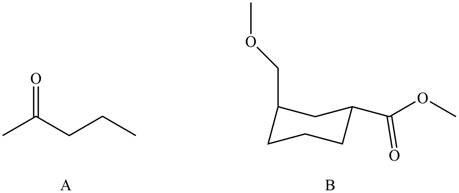
Concept explainers
(a)
Interpretation: The products formed by the treatment of
Concept introduction: Organometallic reagents like
Answer to Problem 20.36P
The products formed by the treatment of

Figure 1
Compound B do not react with
Explanation of Solution
The ball and stick model of compound A and B shows that black balls represent carbon atom, white balls represent hydrogen atom and red balls represent oxygen atom. Therefore, the structure of A and B is,

Figure 2
Ketones on reaction with

Figure 3
The products formed by the treatment of
(b)
Interpretation: The products formed by the treatment of
Concept introduction: Organometallic reagents like
Answer to Problem 20.36P
The products formed by the treatment of

Figure 4
Explanation of Solution
The structure of A and B is shown in Figure 2.
Ketones on reaction with

Figure 5
The products formed by the treatment of
(c)
Interpretation: The products formed by the treatment of
Concept introduction: Organometallic reagents like
Answer to Problem 20.36P
The products formed by the treatment of

Figure 6
Explanation of Solution
The structure of A and B is shown in Figure 2.
Ketones and esters on reaction with Grignard reagent form tertiary alcohol. Therefore, the products formed by the treatment of

Figure 7
The products formed by the treatment of
(d)
Interpretation: The products formed by the treatment of
Concept introduction: Organometallic reagents like
Answer to Problem 20.36P
The products formed by the treatment of

Figure 8
Explanation of Solution
The structure of A and B is shown in Figure 2.
Ketones and esters on reaction with organolithium reagent form tertiary alcohol. Therefore, the products formed by the treatment of

Figure 9
The products formed by the treatment of
(e)
Interpretation: The products formed by the treatment of
Concept introduction: Organometallic reagents like
Answer to Problem 20.36P
Compound A and B do not reaction with
Explanation of Solution
The structure of A and B is shown in Figure 2.
Ketones and esters do not undergo oxidation reaction with
Compound A and B do not reaction with
Want to see more full solutions like this?
Chapter 20 Solutions
Organic Chemistry
- Draw the organic product(s) formed when CH3CH2CH2OH is treated with each reagent. a.H2SO4 b.NaH c.HCl + ZnCl2 d.HBr e.SOCl2, pyridine f.PBr3 g.TsCl, pyridine h. [1] NaH; [2] CH3CH2Br [1] i.TsCl, pyridine; [2] NaSH j.POCl3, pyridinearrow_forwardDraw the products formed when A or B is treated with each reagent. In some cases, no reaction occurs. [1] C6H5Li (excess); [2] H2Oarrow_forwardDraw the product formed when (CH3)2CHOH is treated with each reagent (a, b and c)arrow_forward
- Draw the product formed when (CH3)2CHOH is treated with each reagent (d, e and f)arrow_forwardDraw the product(s) formed when A is treated with each reagent.a. NaBH4, CH3OH b. LiAlH4, then H2O c. Ag2O, NH4OH d. CrO3, H2SO4, H2O e. PCCarrow_forwardWhat would be the reagent for each step?arrow_forward
- Draw all products formed by treatment of each dibromide (A and B) with one equivalent of NaNH2arrow_forwardA. OsO4 and NMO B. Br2 and H20 C. Hg(OAc)2, H2O and NaBH4, NaOH D. RCO3H E. BH3-THF and H2O2, NaOH Which reagent will complete this reaction?arrow_forwardDraw the products formed when (CH3)2C=CH2 is treated with each reagent.a. HBrb. H2OH2SO4c. CH3CH2OH, H2SO4d. Cl2e. Br2, H2Of. NBS (aqueous DMSO)g. [1]BH3;[2]H2O2, HO-arrow_forward
 ChemistryChemistryISBN:9781305957404Author:Steven S. Zumdahl, Susan A. Zumdahl, Donald J. DeCostePublisher:Cengage Learning
ChemistryChemistryISBN:9781305957404Author:Steven S. Zumdahl, Susan A. Zumdahl, Donald J. DeCostePublisher:Cengage Learning ChemistryChemistryISBN:9781259911156Author:Raymond Chang Dr., Jason Overby ProfessorPublisher:McGraw-Hill Education
ChemistryChemistryISBN:9781259911156Author:Raymond Chang Dr., Jason Overby ProfessorPublisher:McGraw-Hill Education Principles of Instrumental AnalysisChemistryISBN:9781305577213Author:Douglas A. Skoog, F. James Holler, Stanley R. CrouchPublisher:Cengage Learning
Principles of Instrumental AnalysisChemistryISBN:9781305577213Author:Douglas A. Skoog, F. James Holler, Stanley R. CrouchPublisher:Cengage Learning Organic ChemistryChemistryISBN:9780078021558Author:Janice Gorzynski Smith Dr.Publisher:McGraw-Hill Education
Organic ChemistryChemistryISBN:9780078021558Author:Janice Gorzynski Smith Dr.Publisher:McGraw-Hill Education Chemistry: Principles and ReactionsChemistryISBN:9781305079373Author:William L. Masterton, Cecile N. HurleyPublisher:Cengage Learning
Chemistry: Principles and ReactionsChemistryISBN:9781305079373Author:William L. Masterton, Cecile N. HurleyPublisher:Cengage Learning Elementary Principles of Chemical Processes, Bind...ChemistryISBN:9781118431221Author:Richard M. Felder, Ronald W. Rousseau, Lisa G. BullardPublisher:WILEY
Elementary Principles of Chemical Processes, Bind...ChemistryISBN:9781118431221Author:Richard M. Felder, Ronald W. Rousseau, Lisa G. BullardPublisher:WILEY





